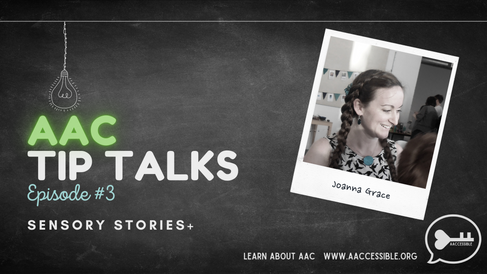
We hear a lot of literacy buzz around the AAC community these days, and with good reason! Literacy skills have power for all of us, perhaps even more so for those who use AAC. If you’ve ever wondered what literacy skills have to do with AAC success, this post is for you! Keep reading to learn more about the building blocks of literacy and what you as a partner need to do to start on a path of literacy with your AAC communicator. And don’t miss the free handout and awesome resources at the end of the post!
What is literacy?
Literacy is the ability to read and write for meaningful purposes. Literacy is also a form of communication, as outlined by The National Council of Teachers of English (NCTE) who state the following regarding literacy, “ It is how we communicate with others via reading and writing, but also by speaking, listening, and creating.”
Why is literacy important in AAC?
Communication is irrevocably tied to literacy. As children progress from young toddlers to school age, communication becomes not just about speaking, but also about writing, with equal emphasis on developing the ability to both comprehend and produce written language. Since no AAC system, no matter how well designed, can possibly hold all the vocabulary in a language, literacy skills are ultimately the only way to give an AAC communicator access to a truly robust vocabulary. Only by being able to generate words by spelling can an AAC communicator access all of the words needed to express anything they want, at any time, to anyone.
How does literacy develop?
Reading
The ability to read develops via two main skills areas; language comprehension and word recognition (Scarborough 2001). Language comprehension refers to a person’s ability to understand the language that they hear, see, or read, and includes component skills like:
Having background knowledge of facts and concepts
A solid vocabulary
Knowledge of language structures (e.g., sentence structure, grammar)
Verbal reasoning skills
Print concepts (e.g., print motivation and print awareness)
Word recognition, as it sounds, refers to the ability to recognize and interpret words. This skill area is built upon foundational skills like:
Phonological awareness (e.g., understanding syllable structures and the phonemes or sounds that make up a language)
Decoding (e.g., alphabetic principles, letter-sound correspondence)
Sight recognition of familiar words (e.g., sight words)
As these skills develop, learners become readers who have fluent word recognition, along with text comprehension. When a learner has well developed word recognition along with comprehension of the language they are decoding, they are considered to be conventional readers. Learners who are still developing these skills are considered emergent readers.
Writing
Writing develops along with reading skills and typically starts with drawing and scribbling. Early writers then begin to write letters that do not create words, followed by using invented spellings for words. Ultimately, writers develop further to use generally conventional spelling and sentence writing (Byington Yaebin Kim, 2017). As with reading, learners progress from emergent skills to conventional skills.
What is emergent literacy?
Erickson and Koppenhaver (2021) describe emergent literacy as all of the reading and writing behaviors and understandings that precede and develop into conventional reading and writing. They discuss the journey to conventional literacy for learners with complex communication needs as one that includes:
Capabilities to communicate with symbols (e.g., letters) sophisticated messages that are widely understood
Spelling abilities that enable composing beyond the limits of AAC systems with graphic symbols
Conventional reading abilities that allow readers to learn about the world or escape into a fictional one
Conventional writing abilities that support complex problem solving, processing of experiences, and wide communication through evolving technologies.
Should I support AAC users with symbol infused text?
Symbolated text refers to a practice where text in storybooks or other reading materials are augmented with images-typically from symbols sets used in AAC systems-by pairing the image above or below key printed words in the text body. While it is tempting to think that using symbolated text to support emergent readers and writers is helpful, this is actually not best practice in the field of literacy instruction. Symbolated text can distract from the print itself, and detour the development of print concepts, such as understanding that letters make up words. Symbolated text can also undermine the process of developing decoding skills (i.e., understanding the way that letters make up a word). Symbolated text may also add unneeded and unhelpful visual complexity to the page. Instead of using symbolated text when addressing literacy with AAC users, we should focus on using symbols and AAC systems to talk about the text, rather than to read the text.
Can SLP's work on literacy skills?
Speech-language pathologists can and should play a role in supporting literacy instruction for learners with speech-language disorders, including AAC users. The American Speech Language Hearing Association has made clear that literacy is a part of a Speech Language Pathologists’ scope of practice as outline their in 2000 and most recently in their 2016 Scope of Practice in Speech-Language Pathology document (p. 16). An SLP can and should support vocabulary development, phonological awareness and phonics skills, comprehension of language, written expression, and more. SLPs can work collaboratively with classroom teachers, occupational therapists, and others (including family members!) to ensure that literacy skills, from emergent to conventional, are addressed, and that all learners, even those with significant disabilities, are given the time and opportunity to become conventional readers.
How do I learn more about literacy instruction for learners
We are working hard to build a comprehensive resource collection for anyone who wants to improve their knowledge and skills with AAC, including those skills related to literacy instruction. Check out these areas of the AACcessible site to find tools, curated collections, and quality, online trainings related to literacy! Click on an image to explore the resource.
References
American Speech-Language-Hearing Association. (2016). Scope of practice in speech-language pathology [Scope of Practice]. Available from www.asha.org/policy/.
Byington Yaebin Kim, T. A. (2017). Promoting Preschoolers’ Emergent Writing. Young Children, 72(5). https://www.naeyc.org/resources/pubs/yc/nov2017/emergent-writing
Erickson, Karen A., and David A. Koppenhaver. Comprehensive Literacy For All, Teaching Students with Significant Disabilities to Read and Write. Brookes, 2021.
National Council of Teachers of English (March 2, 2020) Literacy is More Than Just Reading and Writing. Literacy and NCTE https://ncte.org/blog/2020/03/literacy-just-reading-writing/
Scarborough, H. S. (2001). Connecting early language and literacy to later reading (dis)abilities: Evidence, theory, and practice. In S. Neuman & D. Dickinson (Eds.), Handbook for research in early literacy (pp. 97–110). New York, NY: Guilford Press.https://dyslexiaida.org/scarboroughs-reading-rope-a-groundbreaking-infographic/























